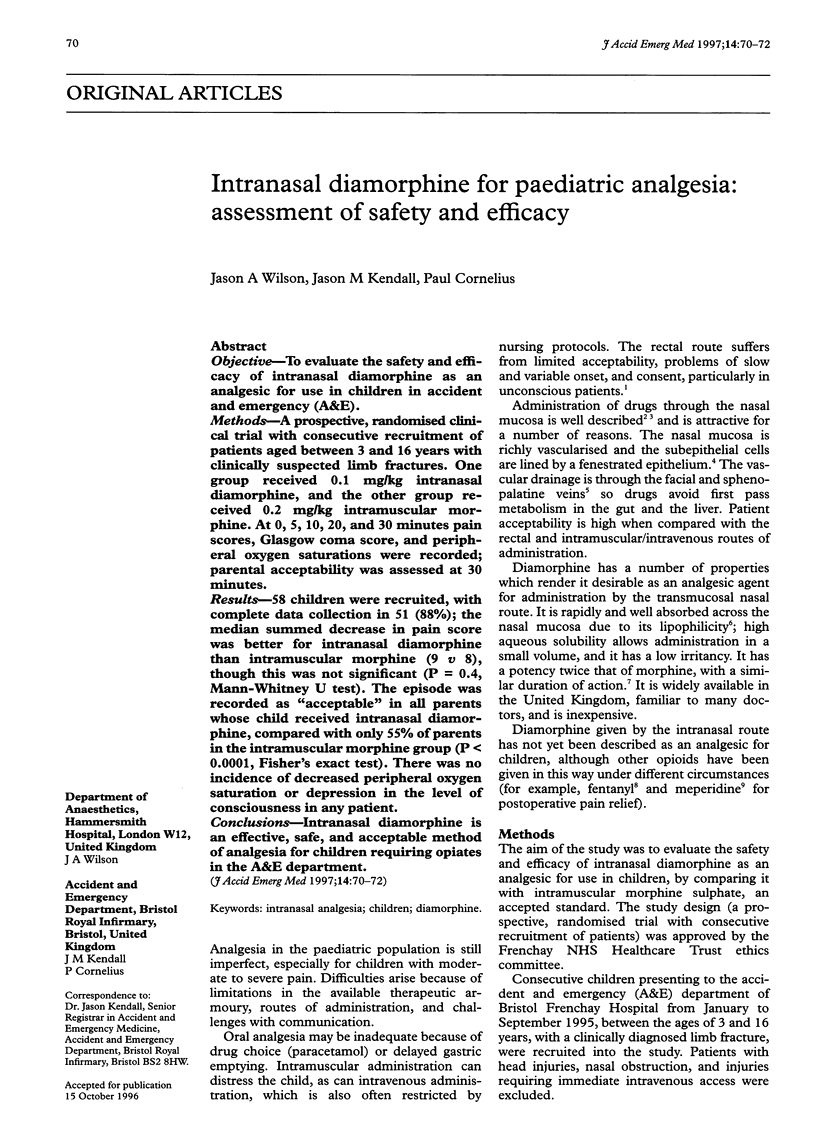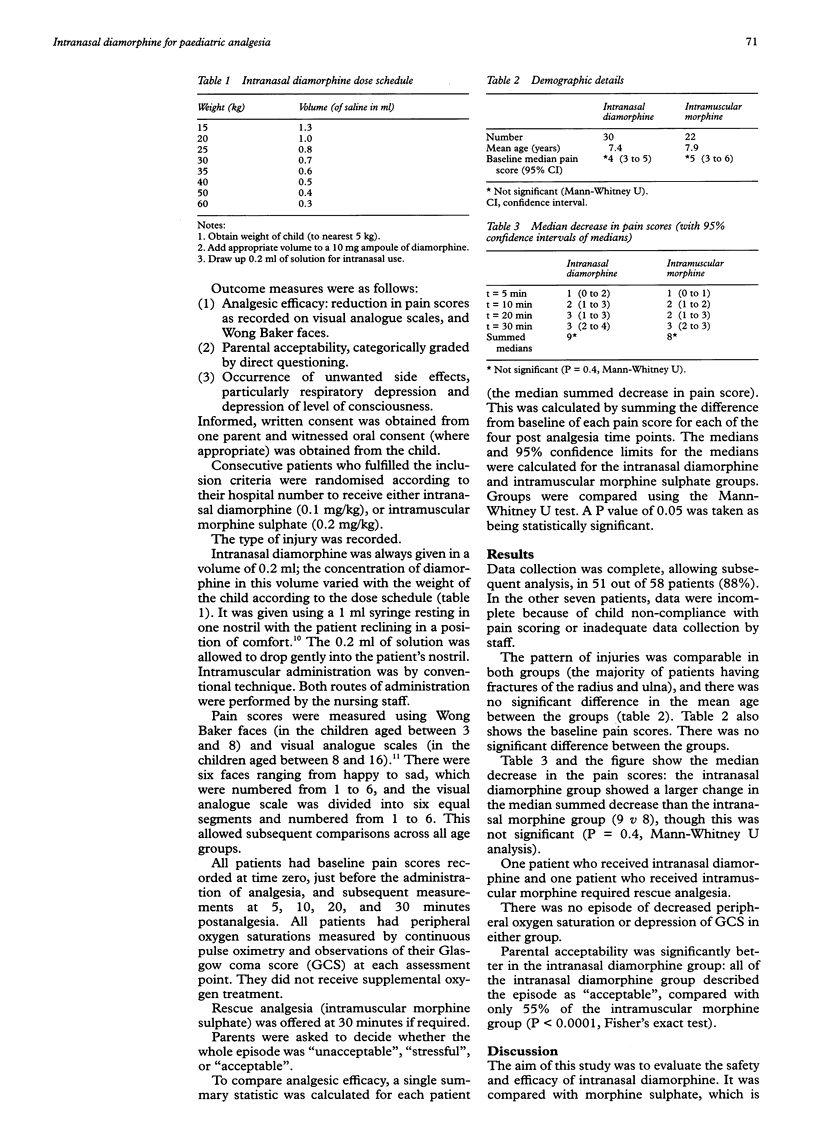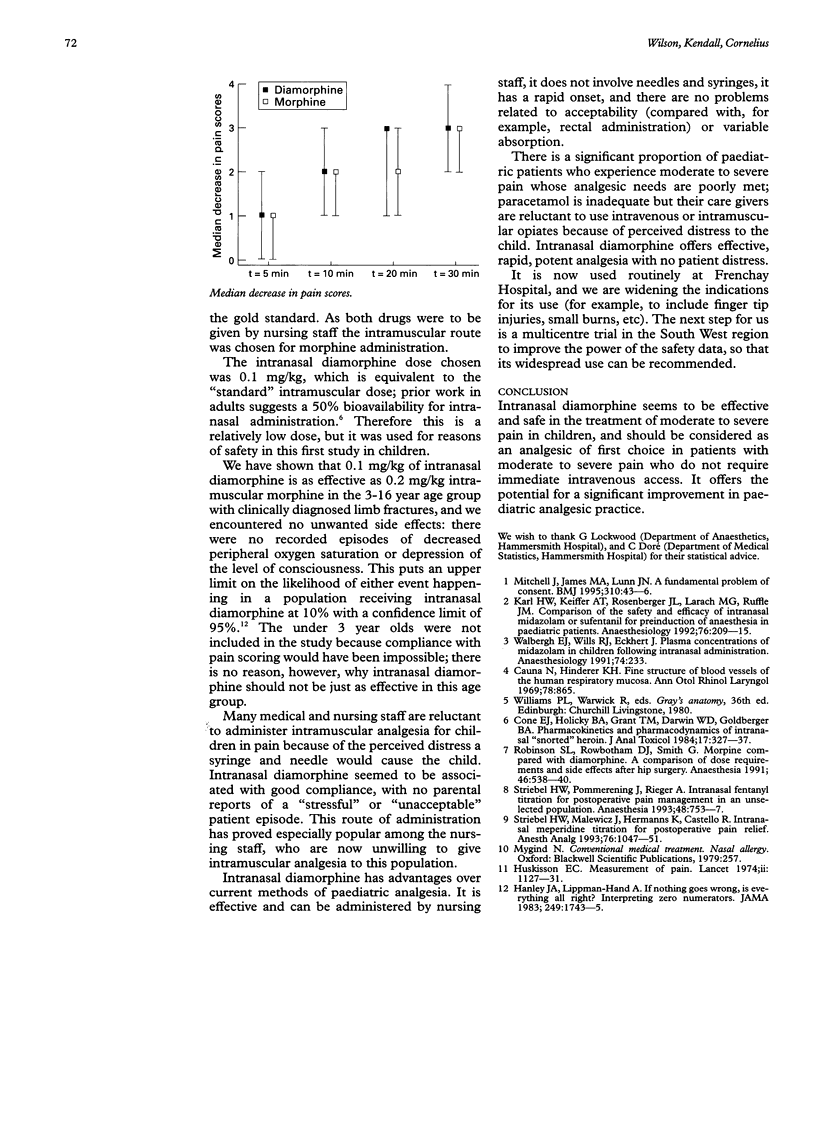Abstract
OBJECTIVE: To evaluate the safety and efficacy of intranasal diamorphine as an analgesic for use in children in accident and emergency (A&E). METHODS: A prospective, randomised clinical trial with consecutive recruitment of patients aged between 3 and 16 years with clinically suspected limb fractures. One group received 0.1 mg/kg intranasal diamorphine, and the other group received 0.2 mg/kg intramuscular morphine. At 0, 5, 10, 20, and 30 minutes pain scores, Glasgow coma score, and peripheral oxygen saturations were recorded; parental acceptability was assessed at 30 minutes. RESULTS: 58 children were recruited, with complete data collection in 51 (88%); the median summed decrease in pain score was better for intranasal diamorphine than intramuscular morphine (9 v 8), though this was not significant (P = 0.4, Mann-Whitney U test). The episode was recorded as "acceptable" in all parents whose child received intranasal diamorphine, compared with only 55% of parents in the intramuscular morphine group (P < 0.0001, Fisher's exact test). There was no incidence of decreased peripheral oxygen saturation or depression in the level of consciousness in any patient. CONCLUSIONS: Intranasal diamorphine is an effective, safe, and acceptable method of analgesia for children requiring opiates in the A & E department.
Full text
PDF


Selected References
These references are in PubMed. This may not be the complete list of references from this article.
- Cauna N., Hinderer K. H. Fine structure of blood vessels of the human nasal respiratory mucosa. Ann Otol Rhinol Laryngol. 1969 Aug;78(4):865–879. doi: 10.1177/000348946907800418. [DOI] [PubMed] [Google Scholar]
- Cone E. J., Holicky B. A., Grant T. M., Darwin W. D., Goldberger B. A. Pharmacokinetics and pharmacodynamics of intranasal "snorted" heroin. J Anal Toxicol. 1993 Oct;17(6):327–337. doi: 10.1093/jat/17.6.327. [DOI] [PubMed] [Google Scholar]
- Hanley J. A., Lippman-Hand A. If nothing goes wrong, is everything all right? Interpreting zero numerators. JAMA. 1983 Apr 1;249(13):1743–1745. [PubMed] [Google Scholar]
- Huskisson E. C. Measurement of pain. Lancet. 1974 Nov 9;2(7889):1127–1131. doi: 10.1016/s0140-6736(74)90884-8. [DOI] [PubMed] [Google Scholar]
- Karl H. W., Keifer A. T., Rosenberger J. L., Larach M. G., Ruffle J. M. Comparison of the safety and efficacy of intranasal midazolam or sufentanil for preinduction of anesthesia in pediatric patients. Anesthesiology. 1992 Feb;76(2):209–215. doi: 10.1097/00000542-199202000-00009. [DOI] [PubMed] [Google Scholar]
- Mitchell J. A fundamental problem of consent. BMJ. 1995 Jan 7;310(6971):43–48. doi: 10.1136/bmj.310.6971.43. [DOI] [PMC free article] [PubMed] [Google Scholar]
- Robinson S. L., Rowbotham D. J., Smith G. Morphine compared with diamorphine. A comparison of dose requirements and side-effects after hip surgery. Anaesthesia. 1991 Jul;46(7):538–540. doi: 10.1111/j.1365-2044.1991.tb09650.x. [DOI] [PubMed] [Google Scholar]
- Striebel H. W., Pommerening J., Rieger A. Intranasal fentanyl titration for postoperative pain management in an unselected population. Anaesthesia. 1993 Sep;48(9):753–757. doi: 10.1111/j.1365-2044.1993.tb07583.x. [DOI] [PubMed] [Google Scholar]
- Striebel W. H., Malewicz J., Hermanns K., Castello R. Intranasal meperidine titration for postoperative pain relief. Anesth Analg. 1993 May;76(5):1047–1051. doi: 10.1213/00000539-199305000-00024. [DOI] [PubMed] [Google Scholar]
- Walbergh E. J., Wills R. J., Eckhert J. Plasma concentrations of midazolam in children following intranasal administration. Anesthesiology. 1991 Feb;74(2):233–235. doi: 10.1097/00000542-199102000-00007. [DOI] [PubMed] [Google Scholar]


